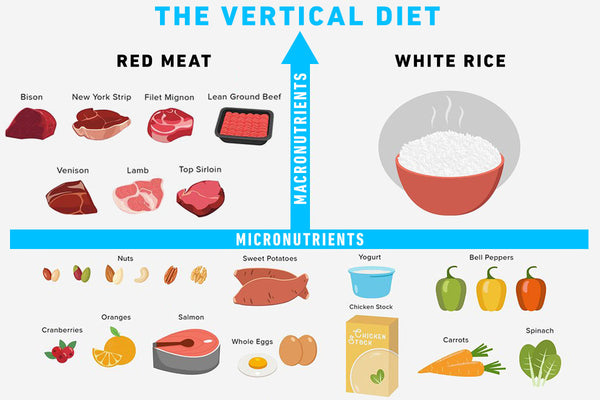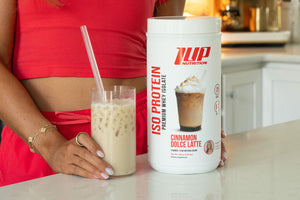What is the Vertical Diet?
The Vertical Diet is a performance-enhancing diet plan designed by Stan “The Rhino” Efferding to optimize an athlete’s digestion and performance.
In Stan’s own words, the Vertical diet is:
“performance-based nutritional framework that starts with a solid foundation of highly bioavailable micronutrients which supports a structure of easily digestible macronutrients that can be adjusted specifically to meet your body’s demands.”[1]
For those of you who don’t know who Stan is, he is quite the accomplished individual. He’s an IFBB professional bodybuilder, competitive powerlifter, business mogul, and winner of the 2010 "Mr. Olympia World's Strongest Professional Bodybuilder”.
So, he knows a thing or two about what it takes to build muscle, gain strength, and out-perfrom the best of the best across the globe.
But, does that mean he knows what he’s talking about when it comes to nutrition?
Let’s find out.
Inside the Vertical Diet
The Vertical Diet prioritizes foods that are “easily digestible macronutrients” while simultaneously supplying “highly bioavailable micronutrients to enhance metabolism and overall digestive health.”[1]
It can be customized to fit any particular dietary predilection or eating pattern as well, meaning it doesn’t matter if you’re low-carb, high-carb, or intermittent fasting -- you can structure the vertical diet such that it keeps you on track with your goals.
Stan has discussed the diet at length on a number of podcasts, so finding information on the diet is pretty easy.
First and foremost, the Vertical Diet focuses on consuming high-quality foods, as Stan believes that not all calories are created equal.
Second, Stan includes only those foods that are considered to be efficiently processed by the body. You see, our bodies may not utilize all of the calories or micronutrients contained in the foods you eat. Due to inefficiencies in the digestive system, some foods may pass through the GI tract and essentially go to “waste”, due to a mix of factors including “anti-nutrients” and poor gut health.
At its core, the Vertical Diet is about maximizing nutrient absorption and utilization so that you perform better and recover faster for greater gains in size and strength.
What Does It Mean to Go “Vertical”?
The way most of us traditionally eat is to eat a wide variety of nutrient-dense foods...after all variety is the spice of life.
This wide variety can be thought of as a broad (horizontal) base of one’s nutrition plan.
The Vertical Diet, however, flips conventional nutrition advice on its head and instead has individuals focus on consuming a limited number of high-quality, micronutrient-rich foods.
Going “vertical” refers to an individual slowly increasing the total number of calories they consume from this limited number of foods each day. The more intense your training demands, the more “vertical” (higher calorie) your diet goes.
According to Stan, the human body can only derive so much benefit from protein and fat. It’s carbohydrates that ultimately fuels athletic performance and muscle growth.
In other words, if you’re training a lot, expect to be eating a lot of carbohydrates on the Vertical Diet. And, to be honest, this is one of the best features about the Vertical Diet. It doesn’t suffer from the abject fear of carbohydrates that 99.9% of all other fad diets do.
Furthermore, according to Stan’s beliefs, restricting the amount of different foods you eat should help your body become more efficient at digestion, since your body can “optimize” the processes involved in digesting a select number of foods rather than have to deal with trying to digest a bunch of different ones.
You can think of it as the difference between being a “jack of all trades” and a “master” of a select few.
In Efferding’s belief, this more efficient digestion and absorption of nutrients should enhance muscle recovery and growth, boost gut health, and stimulate metabolism.
However, most of these beliefs are unfounded according to most nutrition research.
What Foods Can I Eat on the Vertical Diet?
As we’ve said a few times already, the Vertical Diet prioritizes a select group of easily digestible, nutrient-dense foods.
So, what foods are deemed “worthy” of inclusion in the vertical diet?
Two of the foundational ingredients in the Vertical Diet are red meat (steak) and white rice.
The reason for building the diet around these two foods is pretty easy to understand.
Red meat is one of the most micronutrient-dense foods on the planet.[2] It’s rich in B-vitamins, creatine, iron, zinc, and numerous other essential vitamins and minerals.
White rice is an easily digestible carbohydrate that helps athletes hit their higher-than-normal calorie demands while avoiding the bloating, distension, and GI distress that often accompanies eating high amounts of other carb sources.
Other foods included in the “base” of the Vertical Diet are:
- Eggs
- Yogurt
- Spinach
- Salmon
- Oranges and orange juice (to “stimulate” metabolism in Stan’s words”)
- Carrots
- Cooked vegetables
Note: The Vertical Diet advocates consuming “low gas” vegetables, such as butternut squash, celery, carrots, zucchini, cucumber, bell pepper, eggplant, spinach, steamed potato instead of the “usual” veggies that other diets recommend -- broccoli, cauliflower, etc.
However, unlike other diets, which try to make vegetables the primary source of carbohydrate intake, the Vertical Diet has individuals consume enough to satisfy micronutrient requirements, but not so much that individuals experience gassiness, bloating, etc.
What Foods Are Not Recommended on the Vertical Diet?
The Vertical Diet advises individuals to avoid (or extensively limit) foods that aren’t easily digestible.
Typically, this includes high FODMAPs (fermentable oligo-, di-, mono-saccharides and polyols) vegetables, such as onions, garlic, broccoli, and cauliflower, which may cause bloating and gas
Other foods that are discouraged on the diet are:
- Legumes (red beans, black beans, peanuts, etc.)
- Refined seed oils and vegetable oils
- Wheat
- Brown rice
- Other foods that contain “anti-nutrients” such as phytic acid and lectin, which may limit the absorption of certain nutrients.[3,4]
There is a caveat, however. Stan’s Vertical Diet allows for small amounts of whole grains and legumes to be consumed provided that they are “properly” prepared (sprouted or soaked), so as to eliminate the anti-nutrients and make them easier to digest.
This graphic, courtesy of the official Vertical Diet instagram account, sheds further light on what is and what is not allowed on the diet:


Should I Follow the Vertical Diet?
Similar to other diets we’ve discussed on the blog, the Vertical Diet has its high points and it has its not-so-high points.
Starting with the good, the Vertical Diet does emphasize a whole foods approach to meeting one’s nutritional requirements. Furthermore, the diet may be an ideal fit for those who need to follow a low-FODMAPs diet, since the diet emphasizes the consumption of low gas vegetables.
Research has shown that low-FODMAPs diets may help reduce certain GI symptoms (especially in those suffering from IBS), such as cramping, bloating, constipation, and diarrhea.[5,6]
The diet may also benefit individuals who have very high-calorie needs (competitive athletes, bodybuilders, strongman athletes, etc.) who require frequent, high-calorie meals to support their training and recovery as bloating is a common complaint when people have to eat a high volume of food and calories.
However, while the Vertical Diet is primarily a low-FODMAP diet, it does include several high-FODMAP, such as milk, yogurt, cherries, apples, and figs.
Next, Stan advocates consuming foods that cause less stress on the GI system, since it may help reduce the occurrence of inflammation in the gut, thereby supporting digestion, decreasing bloating, and boosting nutrient uptake.
But, there’s a not-so-small problem with this.
A number of the foods that the Vertical Diet suggests to be removed from the diet (broccoli, cabbage, etc.) contain important (and beneficial) prebiotics, which serve as “food” for the beneficial bacteria in your gut.
No single food supplies all the prebiotics needed by the gut, which, by definition, means you should consume a wide variety of foods in order to provide all the “raw materials” your gut microbiome needs to survive and thrive.
By restricting your food selection to a select number of foods, you’re limiting the number of micronutrients you ingest (as well as the ones supplied to your gut bacteria), which sort of counteracts a core principle of The Vertical Diet -- digestive health and function.
The diet also isn’t suitable for vegans or vegetarians due to its heavy reliance on red meat and other sources of animal protein.
Additionally, the Vertical Diet also recommends against the consumption of noteworthy healthy foods like coffee and tea.
Coffee and tea have been extensively studied and shown to not only be healthy but also bountiful sources of antioxidants, which help combat oxidative stress. There are also some data to suggest that higher intakes of coffee are associated with reduced mortality risk and increased life span.[7]
Furthermore, coffee (and caffeine) has also been shown to confer some nootropic and neuroprotective benefits as well.[8] In other words, there’s really no good reason to ban the consumption of coffee or tea.
The Bottom Line on the Vertical Diet
The Vertical Diet was designed to support the increased energy requirements of elite athletes.
Some of the beneficial aspects of the diet are that it focuses on the consumption of whole foods and doesn’t eliminate entire macronutrients from the diet. It’s also fairly customizable based on your own specific calorie needs.
However, the foods allowed on the diet are fairly limited, which can make the diet feel repetitive and restrictive at times. Furthermore, the heavy reliance on red meat can make the diet cost-prohibitive for some.
Finally, many of the claims made by the diet lack considerable evidence in the literature.
If you are an individual who has increased calorie needs and suffers from GI distress, the Vertical Diet may be for you, but if you have no problem digesting a wide variety of foods, there’s no reason to limit the variety of foods you eat daily.
References
- https://stanefferding.com/products/vertical-diet-peak-performance-detailed-program-notes
- "Beef, Ground, 90% Lean Meat / 10% Fat, Loaf, Cooked, Baked [hamburger, Ground Sirloin] Nutrition Facts & Calories." SELF Nutrition Data | Food Facts, Information & Calorie Calculator, 2 Jan. 2018, nutritiondata.self.com/facts/beef-products/6197/2.
- Schlemmer, U., Frolich, W., Prieto, R. M., & Grases, F. (2009). Phytate in foods and significance for humans: food sources, intake, processing, bioavailability, protective role and analysis. Molecular Nutrition & Food Research, 53 Suppl 2, S330-75. https://doi.org/10.1002/mnfr.200900099
- Lagarda-Diaz I, Guzman-Partida AM, Vazquez-Moreno L. Legume Lectins: Proteins with Diverse Applications. Int J Mol Sci. 2017;18(6):1242. Published 2017 Jun 12. doi:10.3390/ijms18061242
- Staudacher, H. M., Whelan, K., Irving, P. M., & Lomer, M. C. E. (2011). Comparison of symptom response following advice for a diet low in fermentable carbohydrates (FODMAPs) versus standard dietary advice in patients with irritable bowel syndrome. Journal of Human Nutrition and Dietetics : The Official Journal of the British Dietetic Association, 24(5), 487–495. https://doi.org/10.1111/j.1365-277X.2011.01162.x
- Halmos, E. P., Power, V. A., Shepherd, S. J., Gibson, P. R., & Muir, J. G. (2014). A diet low in FODMAPs reduces symptoms of irritable bowel syndrome. Gastroenterology, 146(1), 67-75.e5. https://doi.org/10.1053/j.gastro.2013.09.046
- Gunter MJ, Murphy N, Cross AJ, et al. Coffee Drinking and Mortality in 10 European Countries: A Multinational Cohort Study. Ann Intern Med. 2017;167(4):236–247. doi:10.7326/M16-2945
- Kim, J., & Lee, K. W. (2015). Chapter 46 - Coffee and its Active Compounds are Neuroprotective. In V. R. B. T.-C. in H. and D. P. Preedy (Ed.) (pp. 423–427). San Diego: Academic Press. https://doi.org/https://doi.org/10.1016/B978-0-12-409517-5.00046-2






